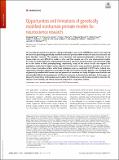Opportunities and limitations of genetically modified nonhuman primate models for neuroscience research
Author(s)
Feng, Guoping; Jensen, Frances E; Greely, Henry T; Okano, Hideyuki; Treue, Stefan; Roberts, Angela C; Fox, James G; Caddick, Sarah; Poo, Mu-ming; Newsome, William T; Morrison, John H; ... Show more Show less
DownloadPublished version (584.7Kb)
Publisher with Creative Commons License
Publisher with Creative Commons License
Creative Commons Attribution
Terms of use
Metadata
Show full item recordAbstract
© 2020 National Academy of Sciences. All rights reserved. The recently developed new genome-editing technologies, such as the CRISPR/Cas system, have opened the door for generating genetically modified nonhuman primate (NHP) models for basic neuroscience and brain disorders research. The complex circuit formation and experience-dependent refinement of the human brain are very difficult to model in vitro, and thus require use of in vivo whole-animal models. For many neurodevelopmental and psychiatric disorders, abnormal circuit formation and refinement might be at the center of their pathophysiology. Importantly, many of the critical circuits and regional cell populations implicated in higher human cognitive function and in many psychiatric disorders are not present in lower mammalian brains, while these analogous areas are replicated in NHP brains. Indeed, neuropsychiatric disorders represent a tremendous health and economic burden globally. The emerging field of genetically modified NHP models has the potential to transform our study of higher brain function and dramatically facilitate the development of effective treatment for human brain disorders. In this paper, we discuss the importance of developing such models, the infrastructure and training needed to maximize the impact of such models, and ethical standards required for using these models.
Date issued
2020Department
Massachusetts Institute of Technology. Department of Brain and Cognitive Sciences; McGovern Institute for Brain Research at MIT; Massachusetts Institute of Technology. Division of Comparative MedicineJournal
Proceedings of the National Academy of Sciences of the United States of America
Publisher
Proceedings of the National Academy of Sciences